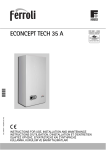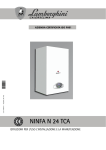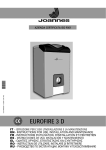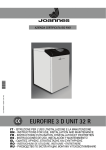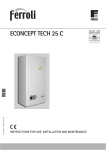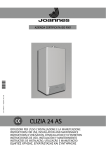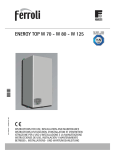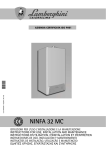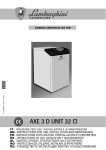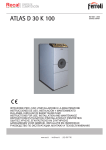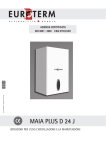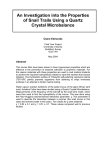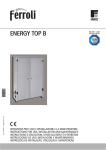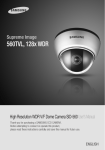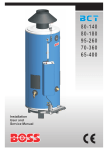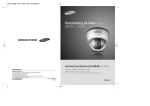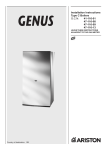Download Lamborghini - Ninfa 32 MC
Transcript
* cod. 3540G380 — 02/2007 (Rev. 00) NINFA 32 MC ISTRUZIONI PER L’USO L'INSTALLAZIONE E LA MANUTENZIONE INSTRUCTIONS FOR USE, INSTALLATION AND MAINTENANCE INSTRUCTIONS D'UTILISATION, D'INSTALLATION ET D'ENTRETIEN INSTRUCCIONES DE USO, INSTALACIÓN Y MANTENIMIENTO INSTRUÇÕES DE INSTALAÇÃO, UTILIZAÇÃO E MANUTENÇÃO ȅǻǾīǴǼȈ ȋȇdzȈǾȈ, ǼīȀǹȉDZȈȉǹȈǾȈ Ȁǹǿ ȈȊȃȉdzȇǾȈǾȈ NINFA 32 MC B • • • • • • Carefully read the warnings in this instruction booklet since they provide important information on safe installation, use and maintenance. This instruction booklet is an integral part of the product and must be carefully kept by the user for future reference. If the unit is sold or transferred to another owner or if it is to be moved, always make sure that the booklet accompanies the boiler so that it can be consulted by the new owner and/or installer. Installation and maintenance must be carried out by professionally qualified personnel, according to current regulations and the manufacturer's instructions. Incorrect installation or poor maintenance can cause damage or physical injury. The manufacturer declines any responsibility for damage caused by errors in installation and use or by failure to follow the manufacturer's instructions. Before carrying out any cleaning or maintenance operation, disconnect the unit from the electrical power supply using the switch and/or the special cut-off devices. • • • • • • In case the unit breaks down and/or functions poorly, deactivate it, do not make any attempt to repair it or directly intervene. Contact professionally qualified personnel. Any repair/replacement of products must only be carried out by qualified professional personnel using exclusively genuine parts. Failure to comply with the above could affect the safety of the unit. Periodical maintenance carried out by qualified personnel is essential for guaranteeing good operation of the unit. This unit must only be used for the purpose for which it was designed. Any other use is considered improper and therefore hazardous. After removing the packing, check the integrity of the contents. Packing materials must not be left within the reach of children as they are potentially hazardous. In case of doubt do not use the unit, and contact the supplier. The images shown in this manual are a simplified representation of the product. In this representation there may be slight, unimportant differences with the supplied product. B This symbol indicates "Caution" and is placed next to all safety warnings. Strictly follow these instructions in order to avoid danger and damage to persons, animals and things. A This symbols calls attention to a note or important notice. Declaration of conformity Manufacturer declares that this unit complies with the following EU directives: • • • • Gas Appliance Directive 90/396 Efficiency Directive 92/42 Low Voltage Directive 73/23 (amended by 93/68) Electromagnetic Compatibility Directive 89/336 (amended by 93/68) President and Legal Representative Cav. del Lavoro Dante Ferroli 28 cod. 3540G380 - 02/2007 (Rev. 00) GB NINFA 32 MC 1 Operating instructions .......................................................................................................... 30 1.1 Introduction........................................................................................................................................... 30 1.2 Control panel ........................................................................................................................................ 30 1.3 Turning on and off ................................................................................................................................ 32 1.4 Adjustments.......................................................................................................................................... 33 2 Installation .............................................................................................................................. 38 2.1 General Instructions ............................................................................................................................. 38 2.2 Installation place................................................................................................................................... 38 2.3 Plumbing connections .......................................................................................................................... 38 2.4 Gas connection .................................................................................................................................... 39 2.5 Electrical connections........................................................................................................................... 40 2.6 Connection to the flue .......................................................................................................................... 40 3 Service and maintenance...................................................................................................... 41 3.1 Adjustments.......................................................................................................................................... 41 3.2 Start-up................................................................................................................................................. 45 3.3 Maintenance ......................................................................................................................................... 45 3.4 Troubleshooting.................................................................................................................................... 47 4 Technical data and characteristics ...................................................................................... 48 4.1 Dimensions and connections ............................................................................................................... 48 4.2 General view and main components .................................................................................................... 49 4.3 Plumbing circuit .................................................................................................................................... 50 4.4 Technical data table ............................................................................................................................. 51 4.5 Diagrams .............................................................................................................................................. 52 4.6 Wiring diagram ..................................................................................................................................... 53 cod. 3540G380 - 02/2007 (Rev. 00) 29 NINFA 32 MC 1. Operating instructions 1.1 Introduction Dear Customer, Thank you for choosing a LAMBORGHINIwall-mounted boiler featuring advanced design, cutting-edge technology, high reliability and quality construction. Please read this manual carefully since it provides important information on safe installation, use and maintenance. NINFA 32 MC is a high-efficiency heat generator for heating and domestic hot water production, running on natural gas or LPG, equipped with an atmospheric burner with electronic ignition and microprocessor control system, and designed for installation indoors or outdoors in a partially protected place (in compliance with EN 297/A6) for temperatures as low as -5°C (-15°C with optional antifreeze kit). 1.2 Control panel 9 1 4 5 6 7 8 3 2 fig. 1 - Control panel Key 1= 2= 3= 0 System temperature adjustment DHW temperature adjustment Selector Off Summer (DHW only) Winter (Heating + DHW) RESET TEST 4= 5= 6= 7= 8= 9= 30 Boiler reset Operation in TEST mode Display Heating mode DHW mode Burner On Economy/Comfort mode Multifunction cod. 3540G380 - 02/2007 (Rev. 00) GB NINFA 32 MC Indication during operation Heating A heating demand (generated by the Room Thermostat or Remote Timer Control) is indicated by lighting up of the radiator (detail 5 - fig. 1). The multifunction display (detail 9 - fig. 1) shows the heating sensor temperature. fig. 2 Domestic hot water (DHW) A DHW demand (generated by drawing domestic hot water) is indicated by lighting up of the tap (detail 6 - fig. 1). The multifunction display (detail 9 - fig. 1) shows the DHW sensor temperature. fig. 3 Comfort A Comfort demand (restoring the temperature inside the boiler) is indicated by lighting up of the tap (detail 6 - fig. 1). The multifunction display (detail 9 - fig. 1) shows the heating sensor temperature. fig. 4 GB cod. 3540G380 - 02/2007 (Rev. 00) 31 NINFA 32 MC 1.3 Turning on and off Boiler not electrically powered fig. 5 - Boiler not electrically powered B The antifreeze system does not work when the power and/or gas to the unit are turned off. To avoid damage caused by freezing during long idle periods in winter, it is advisable to drain all water from the boiler, DHW circuit and system; or drain just the DHW circuit and add a suitable antifreeze to the heating system, complying with that prescribed in sec. 2.3. Boiler lighting Switch on the power to the unit. fig. 6 - Boiler lighting • • • • For the following 120 seconds the display will show FH which identifies the heating system air venting cycle (AIR PURGE function). During the first 5 seconds the display will also show the card software version. Open the gas cock upstream of the boiler. When the message FH disappears, the boiler is ready to operate automatically whenever domestic hot water is drawn or in case of a room thermostat demand. Turning the boiler off Turn the selector (detail 3 - fig. 1) to 0. fig. 7 - Turning the boiler off 32 cod. 3540G380 - 02/2007 (Rev. 00) GB NINFA 32 MC When the boiler is turned off, the electronic board is still powered. Domestic hot water and heating operation are disabled. The antifreeze system stays on. To re-light the boiler, turn the selector (detail 3 fig. 1) to (winter) or (summer). fig. 8 The boiler will be immediately ready to operate whenever domestic hot water is drawn or in case of a room thermostat demand. 1.4 Adjustments Summer/Winter changeover Turn the selector (detail 3 - fig. 1) to (summer). fig. 9 The boiler will only deliver domestic hot water. The antifreeze system stays on. To deactivate Summer mode, turn the selector (detail 3 - fig. 1) to (winter). Heating temperature adjustment Operate the heating knob (detail 1 - fig. 1) to set the temperature between 30°C (min.) and 85°C (max.); it is advisable not to operate the boiler below 45°C. fig. 10 GB cod. 3540G380 - 02/2007 (Rev. 00) 33 NINFA 32 MC Domestic hot water (DHW) temperature adjustment Operate the DHW knob (detail 2 - fig. 1) to set the temperature between 40°C (min.) and 55°C (max.); fig. 11 Room temperature adjustment (with optional room thermostat) Using the room thermostat, set the temperature desired in the rooms. If the room thermostat is not installed the boiler will keep the heating system at its setpoint temperature. Room temperature adjustment (with optional remote timer control) Using the remote timer control, set the temperature desired in the rooms. The boiler unit will set the system water according to the required room temperature. For information on the remote timer control, please refer to its user's manual. ECO/COMFORT selection The unit is equipped with a function that ensures a high domestic hot water delivery speed and maximum comfort for the user. When the device is activated (COMFORT mode), the water contained in the boiler is kept hot, therefore ensuring immediate availability of hot water from the boiler on opening the tap, thus avoiding waiting times. The device can be deactivated by the user (ECO mode) by turning the selector (detail 3 - fig. 1) to the RESET position for 2 seconds and then to (winter) or (summer). To activate COMFORT mode, turn the selector (detail 3 - fig. 1) to RESET again for 2 seconds and then to (winter) or (summer). Sliding temperature When the optional outdoor sensor is installed, the boiler adjustment system works with "Sliding Temperature”. In this mode, the temperature of the heating system is adjusted according outside weather conditions, in order to ensure high comfort and energy saving throughout the year. In particular, as the outside temperature increases the system delivery temperature decreases according to a determinate “compensation curve”. With the Sliding Temperature adjustment, the temperature set with the heating knob (detail 1 - fig. 1) becomes the maximum system delivery temperature. It is advisable to set a maximum value to allow system adjustment throughout its useful operating range. The boiler must be adjusted at the time of installation by qualified personnel. Possible adjustments can in any case be made by the user to improve comfort. 34 cod. 3540G380 - 02/2007 (Rev. 00) GB NINFA 32 MC Compensation curve and curve shift Turn the selector (detail 3 - fig. 1) to RESET for 5 seconds and then to displayed. (winter) or (summer) and “CU” will be Operate the DHW knob (detail 2 - fig. 1) to adjust the required curve from 1 to 10 according to the characteristic (fig. 14). By setting the curve to 0 sliding temperature adjustment is deactivated. fig. 12 - Compensation curve Turn the selector (detail 3 - fig. 1) to RESET for 1 second and then to curve setting and “CU” will be displayed again. (winter) or (summer) to exit compensation Turn the heating knob (detail 1 - fig. 1) clockwise and “OF” will be displayed. Operate the DHW knob (detail 2 - fig. 1) to adjust the curve shift (fig. 15). fig. 13 - Parallel curve shift Turn the selector (detail 3 - fig. 1) to RESET for 5 seconds and then to adjustment mode. GB cod. 3540G380 - 02/2007 (Rev. 00) (winter) or (summer) to exit parallel curve 35 NINFA 32 MC If the room temperature is lower than the required value, it is advisable to set a higher order curve and vice versa. Proceed by increasing or decreasing in steps of one and check the result in the room. 90 85 80 10 9 8 7 6 5 4 70 3 60 2 50 1 40 30 20 20 10 0 -10 -20 fig. 14 - Compensation curves OFFSET = 20 OFFSET = 40 90 85 80 10 9 8 6 5 70 4 60 3 50 2 40 1 30 20 7 20 10 0 -10 -20 90 85 80 10 9 8 7 6 5 4 3 70 2 60 1 50 40 30 20 20 10 0 -10 -20 fig. 15 - Example of parallel compensation curve shift Timer Control (optional) is connected to the boiler, the above adjustments are managed accordA IfingthetoRemote that given in table 1. Table. 1 Heating temperature adjustment Adjustment can only be carried out from the Remote Timer Control menu. DHW temperature adjustment Adjustment can only be carried out from the Remote Timer Control menu. Summer/Winter changeover Summer mode has priority over a possible heating demand from the Remote Timer Control. Eco/Comfort selection On disabling DHW from the Remote Timer Control menu, the boiler selects Economy mode. In this condition, selection from the boiler panel is not possible. On enabling DHW from the Remote Timer Control menu, the boiler selects Comfort mode. In this condition, selection from the boiler panel is possible. Sliding Temperature 36 Both the Remote Timer Control and the boiler card manage Sliding Temperature adjustment: the boiler card Sliding Temperature has priority. cod. 3540G380 - 02/2007 (Rev. 00) GB NINFA 32 MC Water system pressure adjustment The filling pressure with system cold, read on the boiler water gauge, must be approx. 1.0 bar. If the system pressure falls to values below minimum, the boiler card will activate fault F37 (fig. 16). fig. 16 - Low system pressure fault Operate the filling cock (detail 1 - fig. 17) and bring the system pressure to a value above 1.0 bar. A pressure gauge (detail 145 - fig. 25) on the bottom front panel of the boiler displays the pressure even if the unit is not powered. fig. 17 - Filling cock the system pressure is restored, the boiler will activate the 120-second air venting cycle (AIR PURGE A Once function) indicated on the display by FH. At the end of the operation always close the filling cock (detail 1 - fig. 17) GB cod. 3540G380 - 02/2007 (Rev. 00) 37 NINFA 32 MC 2. Installation 2.1 General Instructions BOILER INSTALLATION MUST ONLY BE PERFORMED BY QUALIFIED PERSONNEL, IN ACCORDANCE WITH ALL THE INSTRUCTIONS GIVEN IN THIS TECHNICAL MANUAL, THE PROVISIONS OF CURRENT LAW, THE PRESCRIPTIONS OF NATIONAL AND LOCAL STANDARDS AND THE RULES OF PROPER WORKMANSHIP. 2.2 Installation place This unit is an “open chamber” type and can only be installed and operated in permanently ventilated rooms in compliance with Standard UNI-CIG 7129. If provided with an antiwind grille, the unit is suitable for operation in a partially protected place in compliance with EN 297 pr A6, with min. temperature -5°C. If provided with the special antifreeze kit it can be used with min. temperature as low as -15°C. It is advisable to install the boiler under the slope of a roof, inside a balcony or in a sheltered recess. In any case, the place of installation must be free of dust, flammable materials or objects and corrosive gases. The boiler is arranged for wall mounting and comes standard with a hooking bracket. The LEJ LINE water connection kits also come with a paper template for marking the drilling points on the wall in case the kits are used. Fix the bracket to the wall and hook the boiler onto it. The wall fixing must ensure stable and effective support for the generator. is enclosed in a cabinet or mounted alongside, a space must be provided for removing the casing A Ifandtheforunitnormal maintenance operations. 2.3 Plumbing connections The heating capacity of the unit must be previously established by calculating the building's heat requirement according to current regulations. The system must be provided with all the components for correct and regular operation. It is advisable to install on-off valves between the boiler and heating system allowing the boiler to be isolated from the system if necessary. B The safety valve outlet must be connected to a funnel or collection pipe, to prevent water spurting onto the floor in case of overpressure in the heating circuit. Otherwise, if the discharge valve cuts in and floods the room, the boiler manufacturer cannot be held liable. Do not use the water system pipes to earth electrical appliances. Before installation, carefully wash all the pipes of the system to remove any residuals or impurities that could affect proper operation of the unit. Carry out the relevant connections according to the diagram in sec. 4.1 and the symbols given on the unit. The connection kits shown in the figure below (fig. 18) are supplied standard A A - Female sleeve B - OT 58 nipple C - O-ring D - OT 58 retaining ring E - Copper washer F - OT 58 coupling G - Ball cock A B C D E F G CD E F fig. 18 - Connection kits 38 cod. 3540G380 - 02/2007 (Rev. 00) GB NINFA 32 MC System water charcteristics In the presence of water harder than 25° Fr (1°F = 10ppm CaCO3), the use of suitably treated water is advisable in order to avoid possible scaling in the boiler. The treatment must not in any case reduce the hardness to values below 15°F (Decree 236/88 for uses of water intended for human consumption). Water treatment is indispensable in the case of very large systems or with frequent replenishing of water in the system. If partial or total emptying of the system becomes necessary in these cases, it is advisable to refill it with treated water. Antifreeze system, antifreeze fluids, additives and inhibitors The boiler is equipped with an antifreeze system that turns on the boiler in heating mode when the system delivery water temperature falls under 6°C. The device will not come on if the electricity and/or gas supply to the unit are cut off. If it becomes necessary, it is permissible to use antifreeze fluid, additives and inhibitors only if the manufacturer of these fluids or additives guarantees they are suitable for this use and cause no damage to the heat exchanger or other components and/or materials of the boiler unit and system. It is prohibited to use generic antifreeze fluid, additives or inhibitors that are not expressly suited for use in heating systems and compatible with the materials of the boiler unit and system. Antifreeze kit for outdoor installation (optional) In case of installation in a partially protected place, the boiler must be equipped with the special antifreeze kit for protecting the DHW circuit. The kit comprises a thermostat (A fig. 19) and four electric heaters (R... fig. 19). Connect the kit to the electronic board as given in the wiring diagram (see fig. 27). Position the thermostat and heaters on the DHW circuit pipes as shown in the following diagram. A R1 R3 R2 R4 fig. 19 - Positioning of antifreeze thermostat and heaters External antiwind grille (optional) If the boiler is installed outside in a partially protected place, after carrying out the water and gas connections the special antiwind protection grille must be fitted according to the instructions given in the kit. 2.4 Gas connection B Before making the connection, ensure that the unit is arranged for operation with the type of fuel available and carefully clean all the pipes of the gas system to remove any residues that could affect good functioning of the boiler. The gas must be connected to the relative connector (see fig. 24) in conformity with current standards, with rigid metal pipes or with continuous flexible s/steel wall tubing, placing a gas cock between the system and the boiler. Make sure that all the gas connections are tight. The capacity of the gas meter must be sufficient for the simultaneous use of all equipment connected to it. The diameter of the gas pipe leaving the boiler does not determine the diameter of the pipe between the unit and the meter; it must be chosen according to its length and loss of head, in conformity with current standards. B GB Do not use the gas pipes to earth electrical appliances. cod. 3540G380 - 02/2007 (Rev. 00) 39 NINFA 32 MC 2.5 Electrical connections Connection to the electrical grid B The unit's electrical safety is only guaranteed when correctly connected to an efficient earthing system executed according to current safety standards. Have the efficiency and suitability of the earthing system checked by professionally qualified personnel. The manufacturer is not responsible for any damage caused by failure to earth the system. Also make sure that the electrical system is adequate for the maximum power absorbed by the unit, as specified on the boiler dataplate. The boiler is prewired and provided with a Y-cable and plug for connection to the electricity line. The connections to the grid must be made with a permanent connection and equipped with a bipolar switch whose contacts have a minimum opening of at least 3 mm, interposing fuses of max. 3A between the boiler and the line. It is important to respect the polarities (LINE: brown wire / NEUTRAL: blue wire / EARTH: yellow-green wire) in making connections to the electrical line. During installation or when changing the power cable, the earth wire must be left 2 cm longer than the others. B The user must never change the unit's power cable. If the cable gets damaged, switch off the unit and have it changed solely by professionally qualified personnel. If changing the electric power cable, use solely “HAR H05 VV-F” 3x0.75 mm2 cable with a maximum outside diameter of 8 mm. Room thermostat (optional) B IMPORTANT: THE ROOM THERMOSTAT MUST HAVE VOLTAGE-FREE CONTACTS. CONNECTING 230 V TO THE ROOM THERMOSTAT TERMINALS WILL PERMANENTLY DAMAGE THE ELECTRONIC BOARD. When connecting time controls or a timer, do not take the power supply for these devices from their breaking contacts Their power supply must be by means of direct connection from the mains or with batteries, depending on the kind of device. Accessing the electrical terminal board The terminal board is located at the bottom of the boiler and can be accessed after removing the protection grille (see fig. 20) °C SENSOR 1 2 3 4 1 2 4 3 °C SENSOR 1 2 3 4 fig. 20 - Accessing the terminal board 1-2 3-4 External sensor Room thermostat / Remote timer control (Opentherm) 2.6 Connection to the flue The diameter of the flue connection pipe must not be less than that of the connection on the anti-backflow device. Starting from the anti-backflow device it must have a vertical section at least 50 cm long. Current standards must be complied with regarding the size and installation of the flues and connection pipe. 40 cod. 3540G380 - 02/2007 (Rev. 00) GB NINFA 32 MC 3. Service and maintenance All adjustment, conversion, start-up and maintenance operations described below must only be carried out by Qualified Personnel (meeting the professional technical requirements prescribed by current regulations) such as those of the Local AfterSales Technical Service. LAMBORGHINI declines any liability for damage and/or injury caused by unqualified and unauthorised persons tampering with the unit. 3.1 Adjustments Gas supply conversion The unit can operate on Natural Gas or LPG and is factory-set for use with one of these two gases, as clearly shown on the packing and on the dataplate. Whenever a different gas to that for which the unit is arranged has to be used, a conversion kit will be required, proceeding as follows: 1. Replace the nozzles at the main burner, fitting the nozzles specified in the technical data table in sec. 4.4, according to the type of gas used 2. Modify the parameter for the type of gas: • • • • • • Switch the boiler to standby mode Turn the selector (detail 3 - fig. 1) to RESET for 10 seconds: the display shows “TS” flashing. Turn the selector (detail 3 - fig. 1) to RESET for 1 second: the display shows “P01” Turn the DHW knob (detail 2 - fig. 1) to set the parameter 00 (for operation with natural gas) or 01 (for operation with LPG). Turn the selector (detail 3 - fig. 1) to RESET for 10 seconds The boiler will return to standby mode 3. Adjust the minimum and maximum pressures at the burner (refer to the relevant section), setting the values given in the technical data table for the type of gas used 4. Apply the sticker contained in the conversion kit, near the dataplate as proof of the conversion. TEST mode activation Turn the selector (detail 3 - fig. 1) to the TEST position to activate TEST mode. The boiler lights up at maximum power. The heating (detail 5 - fig. 1) and DHW symbols (detail 6 - fig. 1) flash on the display; the temperature of the heating sensor will be displayed. fig. 21 - TEST mode (heating power = 100%) To deactivate TEST mode, turn the selector (detail 3 - fig. 1) to a different position from TEST. In any case, the TEST mode is automatically deactivated after 15 minutes. GB cod. 3540G380 - 02/2007 (Rev. 00) 41 NINFA 32 MC Burner pressure adjustment Since this unit has flame modulation, there are two fixed pressure settings: minimum and maximum, which must be those given in the technical data table according to the type of gas. • • • • • • • • • • Connect a suitable pressure gauge to the pressure point “B” located downstream of the gas valve. Remove the protection cap “D”. Operate the boiler in TEST mode by turning the selector to the TEST position. Adjust the maximum pressure by turning the screw "G" clockwise to increase the pressure and anticlockwise to decrease it. Disconnect one of the two faston connectors from the modureg "C" on the gas valve. Adjust the minimum pressure by turning the screw "E" clockwise to decrease the pressure and anticlockwise to increase it. Reconnect the faston detached from the modureg on the gas valve. Check that the maximum pressure has not changed. Refit the protection cap “D”. To end TEST mode, turn the selector to a different position from TEST or wait 15 minutes. A After checking or adjusting the pressure, seal the adjustment screw with paint or a special seal. fig. 22 - Gas valve B E C G D Pressure point downstream Min. pressure adjustment Modureg cable Max. pressure adjustment Protection cap Heating power adjustment Refer to the Service Menu section. Lighting power adjustment Refer to the Service Menu section. 42 cod. 3540G380 - 02/2007 (Rev. 00) GB NINFA 32 MC Service Menu The card Service Menu is accessed by turning the selector (detail 3 - fig. 1) to RESET for 10 seconds and then to (winter) or (summer). Use the heating knob (detail 1 - fig. 1) to select “tS”, “In”, “Hi” or “rE”. “tS” means Transparent Parameters Menu, “In” means Information Menu, “Hi” means History Menu, “rE” means History Menu Reset. After selecting the Menu, to access it turn the selector (detail 3 - fig. 1) to RESET for 1 second and then to (winter) or (summer). “tS” - Transparent Parameters Menu The card has 24 transparent parameters modifiable also from Remote Timer Control (Service Menu): Table. 2 Remote Control Card Description of Transparent Parameters Range Default 01 P01 Type of gas selection 0=Natural Gas, 1=LPG 0=Natural Gas 02 P02 Not used Not modifiable 1 03 P03 Absolute min. power 0-100% 0% 04 P04 Lighting power 0-60% 50% 05 P05 Not used Not modifiable 0 06 P06 Heating system train 1-20°C/min 5°C/min 07 P07 Post Circulation heating system pump 0-20 minutes 6 min 08 P08 Heating wait time 0-10 minutes 2 minutes 09 P09 Max. heating power 0-100% 100% 10 P10 Pump operation 0=Post Circulation 1=Continuous 0=Post Circulation 11 P11 Pump switching off temperature during Post Circulation 0-100°C 33°C 12 P12 Max. user setpoint in heating 31-85°C 85°C 13 P13 Post Circulation DHW circuit pump 0-255 seconds 30 seconds 14 P14 DHW circuit wait time 0-255 seconds 120 seconds 15 P15 Max. power in hot water production 0-100% 100% 16 P16 Max. user setpoint in hot water production 55-65°C 55°C 17 P17 Comfort activation temperature 0-80°C 40°C 18 P18 Comfort deactivation hysteresis 0-30°C 20°C 19 P19 Burner turning off in hot water production 0=Fixed, 1=Linked to setp., 2= For solar system1, 3= For solar system2 1=Linked to setp. 20 P20 Not used Not modifiable 4 21 P21 Not used Not modifiable 8 22 P22 Not used Not modifiable 0 23 P23 Not used Not modifiable 0 24 P24 Mains Voltage Frequency 0=50Hz, 1=60Hz 0=50Hz With the heating knob (detail 1 - fig. 1) it is possible to scroll the list of parameters, in increasing or decreasing order respectively. To modify the value of a parameter just turn the DHW knob (detail 2 - fig. 1): the modification will be automatically saved. To go back to the Service Menu turn the selector (detail 3 - fig. 1) to RESET for 1 second and then to (winter) or (summer). To exit the card Service Menu turn the selector (detail 3 - fig. 1) to RESET for 10 seconds and then to (winter) or (summer). GB cod. 3540G380 - 02/2007 (Rev. 00) 43 NINFA 32 MC “In” - Information Menu The card can display the following information: Table. 3 t01 Heating NTC sensor (°C) between 05 and 125 °C t02 DHW NTC sensor (°C) between 05 and 125 °C t03 Not used -- t04 External NTC sensor (°C) between -30 and 70 °C (Negative values flash) t05 Safety NTC sensor (°C) between 05 and 125 °C t06 Actual burner power (%) 00%=Min., 100%=Max. t07 Actual drawing of DHW (Lt_min/10) 00-99 Lt_min/10 t09 Actual system water pressure (bar/10) 00-99 bar/10 t10 Actual ionisation current (uA) 00=burner off The list of information can be scrolled with the heating knob (detail 1 - fig. 1). In case of a damaged sensor, the card will display the hyphens. To go back to the Service Menu turn the selector (detail 3 - fig. 1) to RESET for 1 second and then to (winter) or (summer). To exit the card Service Menu turn the selector (detail 3 - fig. 1) to RESET for 10 seconds and then to (winter) or (summer). “Hi” - History Menu The microprocessor can store the last 10 boiler faults. The Historical datum H1 represents the most recent fault occurring whereas the Historical datum H10 represents the least recent. The codes of the faults saved are also displayed in the relevant menu of the Opentherm remote control. The list of faults can be scrolled with the heating knob (detail 1 - fig. 1). Table. 4 H1 Fault code H2 Fault code H3 Fault code H4 Fault code H5 Fault code H6 Fault code H7 Fault code H8 Fault code H9 Fault code H10 Fault code To go back to the Service Menu just turn the selector (detail 3 - fig. 1) to RESET for 1 second and then to (winter) or (summer). To exit the card Service Menu turn the selector (detail 3 - fig. 1) to RESET for 10 seconds and then to (winter) or (summer). “rE” - Reset History Turn the selector (detail 3 - fig. 1) to RESET for 3 seconds and then to (winter) or (summer) to cancel all the faults stored in the History Menu: the card will automatically exit the Service Menu, in order to confirm the operation. To go back to the Service Menu just turn the selector (detail 3 - fig. 1) to RESET for 1 second and then to or (summer). 44 cod. 3540G380 - 02/2007 (Rev. 00) (winter) GB NINFA 32 MC 3.2 Start-up B Checks to be made at first lighting, and after all maintenance operations involving disconnection from the systems or an intervention on safety devices or parts of the boiler: Before lighting the boiler • • • • • • • • Open any on-off valves between the boiler and the systems. Check the tightness of the gas system, proceeding with caution and using a soap and water solution to detect any leaks in connections. Check the pre-filling of the expansion tank (ref. “Tap water expansion tank pre-filling pressure” sec. 4.4) Fill the water system and make sure that all air contained in the boiler and the system has been vented by opening the air vent valve on the boiler and any vent valves on the system. Make sure there are no water leaks in the system, hot water circuits, connections or boiler. Make sure the electrical system is properly connected and the earth system works properly Make sure that the gas pressure value is as required for heating Make sure there are no flammable liquids or materials in the immediate vicinity of the boiler Checks during operation • • • • • • • • • Ignite the appliance as described in sec. 1.3. Check the airtightness of the fuel circuit and water systems. Check the efficiency of the flue and air-fume ducts while the boiler is working. Check that the water is circulating properly between the boiler and the systems. Make sure that the gas valve modulates correctly in both the heating and hot water production phases. Check the proper ignition of the boiler by performing various tests, turning it on and off with the room thermostat or remote control. Make sure that the fuel consumption indicated on the meter corresponds to that given in the technical data table in sec. 4.4. Make sure that with no call for heating the burner correctly ignites on opening a hot water tap. Check that during heating operation, on opening a hot water tap, the heating circulator stops and there is a regular production of hot water. Check the parameters are programmed correctly and perform any required customization (compensation curve, power, temperatures, etc.) 3.3 Maintenance Periodical check To ensure correct appliance operation over time, have qualified personnel perform a yearly check, providing for the following: • • • • • • • • • • The control and safety devices (gas valve, flow meter, thermostats, etc.) must function correctly. The unit's fume exhaust system must be perfectly efficient. (Sealed chamber boiler: fan, pressure switch, etc. - The sealed chamber must be tight: gaskets, cable glands, etc.) (Open chamber boiler: anti-backflow device, fume thermostat, etc.) The air/fume terminal and ducts must be free of obstructions and leaks The burner and exchanger must be clean and free of deposits. Do not use chemical products or wire brushes to clean. The electrodes must be free of scale and properly positioned. The gas and water systems must be tight. The water pressure in the cold water system must be about 1 bar; otherwise bring it to that value. The circulating pump must not be blocked. The expansion tank must be filled. The gas flow and pressure must correspond to that given in the respective tables. boiler shell, control panel and aesthetic parts can be cleaned with a soft damp cloth, possibly soaked in A The soapy water. Do not use abrasive detergents or solvents. GB cod. 3540G380 - 02/2007 (Rev. 00) 45 NINFA 32 MC Opening the casing To open the boiler casing: 1 2 3 Undo the four screws A Lower the door Lift and remove the casing B B Before carrying out any operation inside the boiler, disconnect the electrical power supply and close the gas cock upstream. B A A fig. 23 Combustion analysis To analyse the combustion: 1 2 3 4 5 Insert the probe in the flue; Open a hot water tap; Adjust the DHW temperature to maximum; Wait 10-15 minutes for the boiler to stabilise; Take the measurement. A Analyses made with an unstabilised boiler can cause measurement errors. 46 cod. 3540G380 - 02/2007 (Rev. 00) GB NINFA 32 MC 3.4 Troubleshooting Diagnostics The boiler is equipped with an advanced self-diagnosis system. In case of a boiler anomaly, the display will flash together with the fault symbol (detail 22 - fig. 1) indicating the fault code. There are faults that cause permanent shutdowns (marked with the letter “A”): to restore operation just turn the selector (detail 3 - fig. 1) to RESET (detail 8 - fig. 1) for 1 second or by means of the RESET on the Remote Timer Control (optional) if installed; if the boiler fails to start, it is necessary to eliminate the fault indicated by the operation LEDs. Faults marked with the letter “F” cause temporary shutdowns that are automatically reset as soon as the value returns within the normal boiler operation range. Table. 5 - Fault list Code fault A01 A02 Fault Burner does not light Flame present signal with burner off A03 Overtemperature protection intervention F04 Fume thermostat intervention (after intervention of the fume thermostat, boiler operation is inhibited for 20 minutes) A06 Possible cause Cure No gas Check the regular gas flow to the boiler and that the air has been eliminated from the pipes Ignition/detection electrode fault Check the wiring of the electrode and that it is correctly positioned and free of any deposits Faulty gas valve Check and replace the gas valve Lighting power too low Adjust the lighting power Electrode fault Check the ionisation electrode wiring Card fault Check the card Heating sensor damaged Check correct positioning and operation of the heating sensor No water circulation in the system Check the circulating pump Air in the system Vent the system Fume thermostat contact open Check the thermostat Wiring disconnected Check the wiring Flue not correctly sized or obstructed Replace the flue Low pressure in the gas system Check the gas pressure Burner minimum pressure setting Check the pressures No flame after the ignition phase Sensor damaged F10 Delivery 1 sensor fault Wiring shorted Check the wiring or change the sensor Wiring disconnected Sensor damaged F11 DHW circuit sensor fault Wiring shorted Check the wiring or change the sensor Wiring disconnected Sensor damaged F14 Delivery 2 sensor fault Wiring shorted Check the wiring or change the sensor Wiring disconnected F34 Supply voltage under 170V. Electric mains trouble Check the electrical system F35 Mains frequency fault Electric mains trouble Check the electrical system System empty Fill the system Water pressure switch not connected or damaged Check the sensor Probe damaged or wiring shorted Check the wiring or change the sensor Sensor disconnected after activating the sliding temperature Reconnect the external sensor or disable the sliding temperature Delivery sensor disconnected from the pipe Check correct positioning and operation of the heating sensor Sensor damaged Change the sensor No H2O circulating in system Check the circulating pump F37 Incorrect system water pressure F39 External sensor fault A41 Sensor positioning F42 Heating sensor fault F43 F50 GB Exchanger protection intervention. Modureg fault Air in the system Vent the system Wiring disconnected Check the wiring cod. 3540G380 - 02/2007 (Rev. 00) 47 NINFA 32 MC 4. Technical data and characteristics 4.1 Dimensions and connections 192 217 420 Ø141 720 315 76,5 61,5 61 80,5 80,5 110 170 145 60 6 1 2 3 4 5 fig. 24 - Dimensions and connections 1= 2= 3= 4= 5= 6= 48 Heating system delivery DHW outlet Gas inlet DHW inlet Heating system return Safety valve drain cod. 3540G380 - 02/2007 (Rev. 00) GB NINFA 32 MC 4.2 General view and main components 126 56 78 27 278 81 20 21 22 14 36 194 42 114 32 290 95 10 8 44 7 39 9 136 145 37 11 fig. 25 - General view 7 8 9 10 11 14 20 21 22 27 32 36 37 39 GB Gas inlet DHW outlet DHW inlet System delivery System return Safety valve Burner assembly Main nozzle Burner Copper exchanger for heating and domestic hot water Heating circulating pump Automatic air vent Water inlet filter Flow regulator 42 44 56 78 81 95 114 126 136 145 194 278 290 cod. 3540G380 - 02/2007 (Rev. 00) DHW temperature sensor Gas valve Expansion tank Anti-backflow device Ignition and detection electrode Diverter valve Water pressure switch Fume thermostat Flow meter Pressure gauge Exchanger Double sensor (Safety + Heating) Antiwind grille (optional) 49 NINFA 32 MC 4.3 Plumbing circuit 126 78 278 56 27 81 20 114 36 44 95 14 32 74 241 42 136 10 8 7 9 11 fig. 26 - Plumbing circuit 7 8 9 10 11 14 20 27 32 36 42 50 Gas inlet DHW outlet DHW inlet System delivery System return Safety valve Burner assembly Copper exchanger for heating and domestic hot water Heating circulating pump Automatic air vent DHW temperature sensor 44 56 74 78 81 95 114 126 136 241 278 cod. 3540G380 - 02/2007 (Rev. 00) Gas valve Expansion tank Heating system cock Anti-backflow device Ignition and detection electrode Diverter valve Water pressure switch Fume thermostat Flow meter Automatic by-pass Double sensor (Safety + Heating) GB NINFA 32 MC 4.4 Technical data table The column on the right gives the abbreviation used on the technical data plate. Data Unit Setting Max heating power kW 34.4 (Q) Min heating power Max heating system heating power kW 11.5 (Q) kW 31.3 (P) (P) Min heating system heating power kW 9.7 Max hot water heating power kW 31.3 Min hot water heating power kW Burner nozzles G20 no. x Ø 9.7 15 x 1.35 Gas feed pressure G20 mbar 20 Maximum pressure downstream from the gas valve (G20) mbar 12.0 Minimum pressure downstream from the gas valve (G20) mbar 1.5 Max gas delivery G20 m 3/h 3.64 Min gas delivery G20 m3/h 1.22 Burner nozzles G31 no. x Ø 15 x 0.79 Gas feed pressure G31 mbar 37 Maximum pressure downstream from the gas valve (G31) mbar 35.0 Minimum pressure downstream from the gas valve (G31) mbar 5.0 Max gas delivery G31 kg/h 2.69 Min gas delivery G31 kg/h 0.90 Efficiency class directive 92/42 EEC - NOx emission class 3 (<150 mg/kWh) (NOx) Max working pressure in heating bar - 3 (PMS) Min working pressure in heating bar 0.8 °C 90 Heating water content litres 1.2 Heating expansion tank capacity litres 10 Heating expansion tank pre-filling pressure bar 1 Max working pressure in hot water production bar 9 bar 0.25 litres 0.3 Max heating temperature Min working pressure in hot water production Hot water content Hot water flow rate 't 25°C l/min 17.9 Hot water flow rate 't 30°C l/min 14.9 Protection class Supply voltage IP V/Hz (D) X5D W 90 Electrical power input in hot water production W 90 Weight with no load kg 31 B11BS PIN CE GB (PMW) 230V/50Hz Electrical power input Type of unit (tmax) 0461BR0843 cod. 3540G380 - 02/2007 (Rev. 00) 51 NINFA 32 MC 4.5 Diagrams Pressure - power diagrams A B A B LPG NATURAL GAS Losses of load / head of circulators H [m H2O] 7 3 6 A 2 5 4 1 3 2 1 0 0 500 1.000 1.500 2.000 Q [l/h] A Boiler losses of head 1 - 2 - 3 Circulator speed 52 cod. 3540G380 - 02/2007 (Rev. 00) GB NINFA 32 MC 4.6 Wiring diagram fig. 27 - Wiring diagram 32 42 44 47 72 81 95 DHW circulating pump DHW temperature sensor Gas valve Modureg Room thermostat (Optional) Ignition/detection electrode Diverter valve B GB 114 126 136 138 139 278 Water pressure switch Fume thermostat Flow meter External sensor Remote Timer Control - Opentherm (Optional) Double sensor (Safety + Heating) Before connecting the room thermostat or the remote timer control, remove the jumper on the terminal block. cod. 3540G380 - 02/2007 (Rev. 00) 53 BRUCIATORI CALDAIE MURALI E TERRA A GAS GRUPPI TERMICI IN GHISA E IN ACCIAIO GENERATORI DI ARIA CALDA TRATTAMENTO ACQUA CONDIZIONAMENTO Le illustrazioni e i dati riportati sono indicativi e non impegnano. La LAMBORGHINI si riserva il diritto di apportare senza obbligo di preavviso tutte le modifiche che ritiene più opportuno per l'evoluzione del prodotto. LAMBORGHINI CALOR S.p.A. VIA STATALE, 342 44047 DOSSO (FERRARA) ITALIA TEL. ITALIA 0532/359811 - EXPORT 0532/359913 FAX ITALIA 0532/359952 - EXPORT 0532/359947 108




























